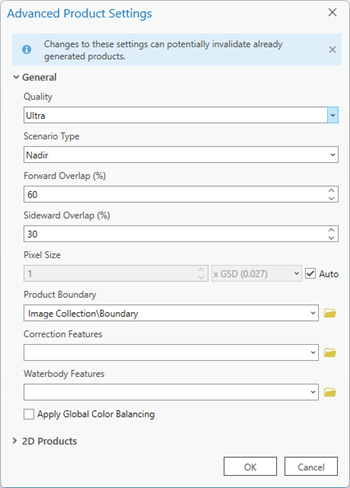Available with Standard or Advanced license.
Available for an ArcGIS organization with the ArcGIS Reality license.
The Multiple Products wizard guides you through the workflow to create a single or multiple ArcGIS Reality for ArcGIS Pro mapping products in a single process. The products that can be generated using the Multiple Products wizards include DSM, True Ortho, DSM Mesh, Point Cloud, and 3D Mesh. The general parameters defined will be applied to all products generated. All generated products will be stored in product folders of the same name under the Reality Mapping category in the Catalog pane.
To generate products using the ArcGIS Reality for ArcGIS Pro Multiple Products wizard, follow the steps below.
Note:
Before you begin the workflow, ensure that you have created a Reality mapping workspace and completed the block adjustment process.
- On the Reality Mapping tab, click the Multiple Products button
 in the Product group.
in the Product group.The Reality Mapping Products Wizard window appears.
- Click Shared Advanced Settings.
The Advanced Product Settings dialog box appears, where you can define parameters that will determine the Reality mapping products to be generated. For a detailed description of the advanced product settings options, see Advanced Product Settings in the wizard.

- Quality and Scenario settings are automatically set by the application and should not be changed to ensure optimum performance and product quality. However, if you want to generate a reduced resolution product, the Quality setting can be lowered. See Shared Advanced Settings above for more information on the impact of various Quality settings on product generation.
During initial product generation, the Reality mapping process creates files based on product settings that are used to reduce processing duration of subsequent products. Changing the Quality setting after initial product generation adversely impacts processing time and initiates regeneration of previously created files and products.
- For Product Boundary, select a feature class identifying the output product extent from the drop-down list or click the Browse button
 and browse to one.
and browse to one. It is recommended that you provide a project boundary for the following reasons:
- Define the proper output extent—When you do not define a product boundary, the application automatically defines an extent based on various dataset parameters that may not match the project extent.
- Reduce processing time—If the required product extent is smaller than the image collection extent, defining a product boundary reduces the processing duration and automatically clips the output to the boundary extent.
- To specify a water body feature layer, click the Browse button
 next to Waterbody Features and browse to one.
next to Waterbody Features and browse to one.If water features such as lakes and rivers exist within the project area, it is recommended that you add a pre-created 3D feature class identifying those areas using the Waterbody Features option to hydrologically enforce these features in the output product. Use the stereoscopic compilation in ArcGIS Image Analyst to generate the 3D feature layer that identifies water body features. This ensures that no image stretching occurs around hydrological feature boundaries in the output due to differences in elevation between the derived DSM height and the feature class height values.
- Accept all other defaults and click OK.
The Advanced Product Settings dialog box closes, and you return to the Products Generation Settings page in the Reality Mapping Products wizard.
- Check the box next to the products to be generated.
- Click Next in the Reality Mapping Products Wizard window to advance to a settings page that is specific to the product or products selected.
- Select the appropriate product-related options.
- Repeat steps 8 and 9 until all selected product parameters have been defined.
- Click Finish to initiate product processing.
When processing is complete, the generated products are added to the appropriate locations:
- The Contents pane, Data Products category, and the 2D map view
- The appropriate product folder in the Reality Mapping container, in the Catalog pane